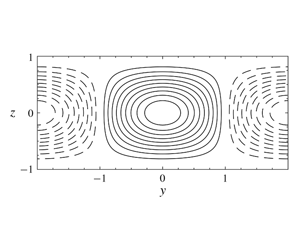Crossref Citations
This article has been cited by the following publications. This list is generated based on data provided by
Crossref.
Liu, Chang
and
Gayme, Dennice F.
2021.
Structured input–output analysis of transitional wall-bounded flows.
Journal of Fluid Mechanics,
Vol. 927,
Issue. ,
Barthel, Benedikt
Zhu, Xiaojue
and
McKeon, Beverley
2021.
Closing the loop: nonlinear Taylor vortex flow through the lens of resolvent analysis.
Journal of Fluid Mechanics,
Vol. 924,
Issue. ,
Liu, Chang
Caulfield, Colm-cille P.
and
Gayme, Dennice F.
2022.
Structured input–output analysis of stably stratified plane Couette flow.
Journal of Fluid Mechanics,
Vol. 948,
Issue. ,
Cavalieri, André V. G.
and
Nogueira, Petrônio A. S.
2022.
Reduced-order Galerkin models of plane Couette flow.
Physical Review Fluids,
Vol. 7,
Issue. 10,
Madhusudanan, Anagha
Illingworth, Simon J.
Marusic, Ivan
and
Chung, Daniel
2022.
Navier-Stokes–based linear model for unstably stratified turbulent channel flows.
Physical Review Fluids,
Vol. 7,
Issue. 4,
Chiarini, Alessandro
Mauriello, Mariadebora
Gatti, Davide
and
Quadrio, Maurizio
2022.
Ascending–descending and direct–inverse cascades of Reynolds stresses in turbulent Couette flow.
Journal of Fluid Mechanics,
Vol. 930,
Issue. ,
Dokoza, Toni
and
Oberlack, Martin
2023.
Reynolds number induced growth of the large-scale rolls in plane Couette flow using resolvent analysis.
Journal of Fluid Mechanics,
Vol. 968,
Issue. ,
Dokoza, Toni
Hennings de Lara, Joao Vinicius
and
Oberlack, Martin
2024.
Invariant scaling laws for plane Couette flow with wall-transpiration.
Physics of Fluids,
Vol. 36,
Issue. 3,
Andreolli, A.
Singh, M.K.
and
Gatti, D.
2024.
Skin friction reduction via suppression of large scales in turbulent Couette flows.
International Journal of Heat and Fluid Flow,
Vol. 108,
Issue. ,
p.
109444.
Dokoza, T.
and
Oberlack, M.
2024.
Progress in Turbulence X.
Vol. 404,
Issue. ,
p.
57.
Vorspohl, J
Burchardt, L
Meinke, M
Brümmer, A
and
Schröder, W
2024.
High-resolution simulations of gas-liquid Couette-type sealing gap flows.
IOP Conference Series: Materials Science and Engineering,
Vol. 1322,
Issue. 1,
p.
012004.
Zhu, Wenkai
Chen, Xianliang
and
Fu, Lin
2024.
Resolvent analyses of incompressible turbulent channel, pipe and boundary-layer flows.
International Journal of Heat and Fluid Flow,
Vol. 106,
Issue. ,
p.
109331.
Andreolli, A.
Hutchins, N.
Frohnapfel, B.
and
Gatti, D.
2025.
Temporal decay of secondary motions in turbulent channel flows.
Journal of Fluid Mechanics,
Vol. 1007,
Issue. ,
Madhusudanan, Anagha
Stroot, Gregory
and
McKeon, Beverley. J.
2025.
A resolvent-based perspective on the generation of Mach wave radiation from compressible boundary layers.
Journal of Fluid Mechanics,
Vol. 1003,
Issue. ,
Dokoza, Toni
Hennings de Lara, Joao Vinicius
and
Oberlack, Martin
2025.
Diminishing effect of a pressure gradient on large-scale rolls of plane Couette flow: A singular value analysis.
Physical Review Fluids,
Vol. 10,
Issue. 2,

 $4h$, where
$4h$, where  $h$ is the channel half-height) are to an important degree encoded in the Orr–Sommerfeld operator alone, thus helping to explain their prevalence. Second – and consistent with numerical and experimental observations – that Couette flow is significantly more efficient than Poiseuille flow in leveraging the mean shear to produce channel-wide streamwise streaks.
$h$ is the channel half-height) are to an important degree encoded in the Orr–Sommerfeld operator alone, thus helping to explain their prevalence. Second – and consistent with numerical and experimental observations – that Couette flow is significantly more efficient than Poiseuille flow in leveraging the mean shear to produce channel-wide streamwise streaks.